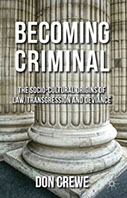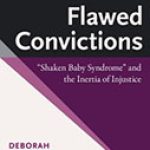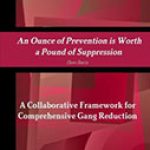Becoming Criminal: The Socio-Cultural Origins of Law,
Transgression, and Deviance

Author: Don Crewe
Publisher: London; New York: Palgrave Macmillan, 2013. 226p.
Reviewer: Stéphane Lefebvre | September 2014
Dr. Don Crewe is Senior Lecturer at Leeds Metropolitan University in the United Kingdom. He is known for his work as a critical criminologist, a philosopher of social structures, and a criminal justice ethicist (see his profile at http://www.leedsbeckett.ac.uk/staff/dr-don-crewe/). This book, if you are not familiar with critical criminology, will be daunting. Although Crewe provides regular and useful summaries of his argument as it builds up throughout the book, his prose is serious and at times overly complicated, with only a handful of real-life cases to illustrate particular points. That said, the argument is methodically and progressively laid out, theoretically rich, and worth making the effort to get through it.
Crewe’s punch lines, in my opinion, come toward the end of the book at pages 176-177. These lines redefine what criminology is and what it should investigate. They are worth quoting:
[…] there are no acts that are inevitably crimes, there are no people who are inevitably criminal. Thus we cannot speak of the causes of crime; we may only speak of events that are seen as deviant. Some of these events will be codified in law as criminal. These events are not to be identified by any quality of rightness or wrongness, or any kind of social or psychological pathology, but merely by the power of the group doing the criminalizing.What criminology should investigate in addition to those factors that contribute to the individual motivation to behave in a particular way is the collective processes that tend to homogenize meanings and behaviour such that laws are generated and thus breached, or that norms are generated and some harmful acts thus not criminalized. What are the actual mechanisms that individuals use to enable them to define the situation as one where certain norms apply? Thus the object of criminological study is the body of processes, individual and collective that produce normalizing effects on behaviour or which bring about choices that deviate from those norms […]. What matters are the processes that define [an event] as deviant or normal, and assemblage theory gives us a framework within which to conceive of those processes.
These are powerful statements making crime a concept instead of a behaviour, and law the written expression of those who have the capacity to make law. At first glance they are appealing because they are intuitively right, commonsensical, and reflective of some reality. When I read them I immediately thought of Nazi Germany and the power of Hitler’s regime to criminalize whatever it wanted, and homogenize meanings through massive propaganda and indoctrination efforts. I also thought of the controversies surrounding the German population and its alleged complicity with the Nazi regime, which in essence were about how, and under what circumstances, they came to define their situation as one where Nazi norms applied or not. The passages and in particular the words I underlined above, however, must be unpacked. And this is exactly what Crewe does in the preceding 175 pages. He builds up his argument point by point, defending his definitions, articulations and explanations, and answering possible criticisms. He does that in three distinct parts: In Part I, he answers the question “What Is Theory?”, and in Parts II and III he addresses the dynamics of will and constraint. At heart, Crewe disagrees with a criminology that adopts classifications of domination and control that—through institutions, practices and discourses—subjugate and oppress. He argues instead that classificatory practices are culturally contingent and makes the issue of how they arise the overall subject of his book.
In Part I, Crewe takes issue with criminologists who assume that theory should be able to explain the causes of crime. He demonstrates through logic that the deductive nomological model, the inductive statistical model and the statistical relevance model each have fundamental flaws and that, hence, “the provision of explanations cannot be a necessary requisite of theory in the social sciences […]” (p. 35). He writes as well that causal associations are no more than a way to organize our perception of the world, that there is no rational foundation for them, and that we can never be sure what they are. The obvious implication, of course, is that controlling crime is not feasible to the extent that many criminologists think it is (p. 45). Therefore, causes are no more necessary to theory than explanations are. Hence, Crewe defines theory not as a tool “for truth generating or certainty providing” (p. 14) but instead as “a tool for making sense of the world” by providing a grammar “for making sense of the relationship between [the] concepts” (pp. 10-11) that form its internal elements. More concretely, a theory should enable us
to make sense of the relationships between phenomena as they appear to us. The detail of this last sentence is crucial; theory does not represent real relationships between real objects in the real world, but provides a consistent metaphor for those relationships that allows us to make sense of the way we represent them to ourselves, perhaps in a way that has utility for the solutions of problems, for example. (p. 47)
The concepts that Crewe sees theory expressing “things about” (p. 57) their relationships are will, power, and constraint. Crewe refers to constrained will instead of the agency/structure dualism as a better way to understand human behavior. After all, he writes, agency cannot “situate human choices within complex social histories, structures, and processes – pasts, presents […]” (p. 83). The interpretation of the latter, Crewe later adds, “informs the individuals’ behaviour in reproducing the institutions or cultures of which they are a part” (p. 99). In other words, the choices that individuals make about their behaviour are in relation “to the perception of themselves as objects of the future,” and their perception of the nature of their history and current circumstance (pp. 115-116), which can be socially conditioning (constraining or enabling). To be constrained does not mean that individuals have no will. They can see themselves in the future in any way they want but will not always be able to exercise that choice. This is not because of social controls, but because of a historical a priori, a past environment that now limits or constrains their imagination of themselves as objects of the future. This is also because of a difference in power between people. As Crewe explains:
[O]ur choices are restricted to those suitable to the ‘situation’, and […] some people have more power than others to define what that situation is, hence some more or less powerful people define the situation and those others in the situation are thus constrained to bring to it only those behaviours drawn from referents that are compatible with that definition: failure to observe this rule makes one deviant or transgressive (p. 125).Crewe defines power as “an expression of continuous and universal (though unequal) distribution of capacities” (his emphasis) (p. 140); it equates to the “capacity to do something” (p. 145), and not to the ability to do something, because abilities can be constrained. It also should not be confused with influence: “power equates to the effecting of consequences” (his emphasis) whereas influence “equates to affecting things or people” (p. 153). However, if one has power, one can influence things or people. Accordingly, institutions or social structures are greater than the sum of their parts “because capacities emerge from their assemblage” (his emphasis) (p. 164) what matters in the analysis of the structure of societies is not their properties but the distribution of capacities. A larger and more durable assemblage (say a government versus a crowd of demonstrators) has more capacities to define a situation “as one whose norms require the creation of legal definitions should they be breached” (p. 176). It is therefore the concept crime that creates law:
Crime in this view is the inevitable effluent of assembling processes of cultures and institutions […]. What this means for criminology is that there are no acts that are inevitably crimes, there are no people who are inevitably criminal. Thus we cannot speak of the causes of crime; we may only speak of events that are seen as deviant. (p. 176)
Crewe’s tour de force has fundamental implications for criminology. It refocuses research on what produces “normalizing effects on behavior” on an equal footing with what “bring about choices that deviate from those norms” (p. 177). As historian John Lewis Gaddis once noted, “departures from the norm are always less difficult to measure than the norm itself.”1 In criminology, the question usually asked is “why do people deviate from legal norms” instead of the more prevalent situation that the question “why do most people, most of the time conform?” represents.2 Crewe’s compelling analysis will hopefully bring a more balanced and equally useful approach to the field.
Notes
- John Lewis Gaddis, “International Relations Theory and the End of the Cold War,” International Security 17:3 (1992-1993) at 25
- Adam Crawford, “‘Sticks and Carrots… and Sermons’: Some Thoughts on Compliance and Legitimacy in the Regulation of Youth Anti-Social Behaviour” in Adam Crawford & Anthea Hucklesby, eds, Legitimacy and Compliance in Criminal Justice (New York, NY: Routledge, 2013) p. 196.
Stéphane Lefebvre is a PhD candidate at the Department of Law & Legal Studies of Carleton University in Ottawa, Canada. He has published over 20 book chapters and journal articles and over 75 book reviews.


